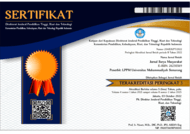Strategi Pemasaran Serbuk Jamu Instan UMKM Tiga Dara di Masa Pandemi Covid 19
(1) Fakultas Sains dan Matematika, Universitas Diponegoro, Semarang, Indonesia
(2) Fakultas Ekonomi, Universitas Negeri Semarang, Semarang, Indonesia
(3) Fakultas Sains dan Matematika, Universitas Diponegoro, Semarang, Indonesia
(4) Fakultas Sains dan Matematika, Universitas Diponegoro, Semarang, Indonesia
(*) Corresponding Author
Abstract
Empowerment of Micro, Small and Medium Enterprises (MSME), requires model empowerment, which includes increasing existing MSME to be more advanced in order to be able to compete tightly in free market competition. Since ancient times, empon empon has been proven to have medicinal properties as herbal medicine, which is not only used as a medicine but also as a beauty treatment. One of the MSME that processes empon-empon into instant herbal medicine is Tiga Dara MSME which is located at Jalan Urip Sumoharjo No. 45 East Ungaran Subdistrict, Semarang Regency. Instant herbal powders produced by UD Tiga Dara include instant powders of Ginger, Turmeric, Temulawak, Mahkota Dewa, Kencur etc. The importance of maintaining body immunity during the COVID-19 pandemic is closely related to the availability of instant herbal powder products with empon-empon raw materials, especially ginger. During this pandemic, the demand for instant herbal medicine powder has increased, but Tiga Dara MSME still have limitations in the sales system. The method used in this community service is in the form of training and mentoring MSME in making web and social media as a means of marketing instant herbal powder products. This service aims to assist MSME in marketing their products in order to improve the economy of Tiga Dara MSME. With the existence of the Web and social media as one of the media for product marketing, it is hoped that it can increase sales from MSME and can improve the community's economy so that it can achieve community welfare.
Keywords
Full Text:
PDFReferences
Fathorazi dan Hilda. (2020). Pembuatan Dan Pembagian Obat Tradisional Empon-Empon Sebagai Bentuk Kepedulian Pencegahan Pandemi Covid-19.Probolinggo : Universitas Nurul Jadid
Kannan and L. Hongshuang. (2017) "Digital Marketing: A Framework, Review and Research Agenda," International Journal of Research in Marketing, vol. 34, no. 1, pp. 22-45.
Kasali, R. (2011). Cracking Zone. Jakarta: Gramedia Pustaka Utama.
Kingsnorth, S. (2016). Digital Marketing Strategy: An Integrated Approach to Online Marketing. Philadelphia: Kogan Page.
Lara, "Top Digital Marketing Trends for 2020 and 2021," 14 July 2020. [Online]. Available: https://www.theedigital.com/blog/digitalmarketing-trends.
Miller, R., Lammas, N. (2009). Social Media and its Implication for Viral Marketing. Asia Pacific Public Relation Journal, vol 11, pp. 1-9.
Mulyani, Hesti dkk. (2016). Tumbuhan Herbal Sebagai Jamu Pengobatan Tradisional Terhadap Penyakit Dalam Serat Primbon Jampi Jawi Jilid I. Yogyakarta: Jurnal Penelitian Homaniora
Priambada, Swasta. (2015). Manfaat Penggunaan Media Sosial Pada Usaha Kecil Menengah (UKM). Seminar Nasional Sistem Informasi Indonesia.
Sanjaya, R., & Tarigan, J. (2009). Creative digital marketing : teknologi berbiaya murah, inovatif, dan berdaya hasil gemilang. Jakarta: Elex Media Komputindo.
Tomarda, Zakky Caksana. (2018). Strategi Promosi Pemasaran Produk Pada Perusahaan Jamu Bisma Sehat.. Surakarta. Universitas Muhammadiyah Surakarta.
Article Metrics
Abstract view : 610 timesPDF - 171 times
DOI: https://doi.org/10.26714/jsm.4.2.2022.154-159
Refbacks
- There are currently no refbacks.
Copyright (c) 2022 Jurnal Surya Masyarakat

Jurnal Surya Masyarakat (JSM) is licensed under Creative Commons Attribution-NonCommercial-NoDerivatives 4.0
------------------------------------------------------------------------------------------------------------------------
Jurnal Surya Masyarakat (JSM)
p-ISSN: 2623-0364; e-ISSN: 2623-0569
Published by: Lembaga Penelitian dan Pengabdian Masyarakat (LPPM) Universitas Muhammadiyah Semarang



.jpg)







.jpg)